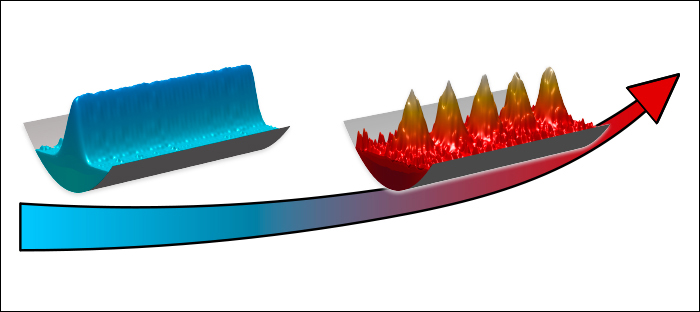| May 23, 2023 |
Study demonstrates that heat can freeze fluids in the quantum world
(Nanowerk News) At the beginning of springtime, snow and ice start to melt as temperatures rise. This phenomenon exemplifies the transition from solid to liquid when thermal energy is added to matter. We can easily observe this in nature. Continued heat will cause the liquid to evaporate, according to the laws of physics that we all know.
|
|
Now, a recent discovery, published in Nature Communications ("Heating a dipolar quantum fluid into a solid"), turns this notion on its head and establishes that extreme heating of a fluid can also cause it to transition to a solid state. However, the system created is not the ordinary kind of solid that we know and, unlike ice cubes in water, only forms under extreme conditions, in which the effects of quantum mechanics start to play a decisive role.
|
 |
| Illustration showing the solidification of a liquid with increased temperature. (Image: UPC)
|
|
In fact, the laws of quantum mechanics allow for the emergence of unusual forms of matter, which defy the simple categorisation into solids, fluids and gases. One of such exotic states is the so-called supersolid. In a supersolid, particles arrange themselves to freeze into an ordered state and, yet, at the same time can flow through the formed structure without any friction. Thus, they have both solid and superfluid properties.
|
|
This seeming contradiction has fascinated the scientific community for a few decades, dating back to the first conjecture of supersolidity more than 50 years ago. However, scientists only recently found ways to explore these questions in actual experiments. This has become possible through a quantum version of so-called ferrofluids: microscopic magnetic particles suspended in a fluid.
|
Experimenting with quantum ferrofluids
|
|
Invented at NASA in the 1960s, ferrofluids are magnetic colloids that have numerous surprising properties and that can be applied in electronics, mechanical engineering and other industries. In a quantum ferrofluid, the magnetic particles correspond to single atoms. In the laboratory, such dipolar quantum fluids are microscopic droplets that contain some 10,000 atoms, which are cooled down by laser light to extremely low temperatures near absolute zero.
|
|
Extreme conditions like that can force all the atoms to retreat into a single quantum state and form a so-called Bose-Einstein condensate. This state can be thought of as a fluid that can propagate without resistance—a superfluid with zero viscosity. In a dipolar superfluid, the magnetic interaction between the atoms can trigger the emergence of regular patterns in the condensate. The resulting state corresponds to a supersolid, an exotic state of matter that was observed a few years ago in a series of ground-breaking experiments.
|
New knowledge to solve scientific puzzles
|
|
Building on these findings, a collaboration between researchers from the Universitat Politècnica de Catalunya - BarcelonaTech (UPC), the University of the Balearic Islands (UIB) in Palma de Mallorca, the Aarhus University in Denmark and the University of Innsbruck in Austria set out to understand the role that temperature plays in the phenomenology of dipolar supersolids.
|
|
While most previous experimental measurements had been conducted at the lowest achievable temperatures, the experiment at the University of Innsbruck was designed to study the supersolid melting behaviour under a controlled variation of temperature. To everyone’s surprise, the data revealed that increasing the temperature could trigger the formation of a supersolid instead of the expected melting behaviour.
|
|
The theory was developed by Juan Sánchez Baena, a postdoctoral researcher at the UPC’s Computer Simulation in Condensed Matter Group (SIMCON), during a research visit at Aarhus University, together with Aarhus professor Thomas Pohl and UIB professor Fabian Maucher.
|
|
The researchers offered an intuitive explanation for this seemingly paradoxical behaviour. Raising the temperature usually increases fluctuations in a system and speeds up the thermal motion of particles. If this motion becomes too large, a solid melts or a fluid vaporises. Raising the temperature of a Bose-Einstein condensate also increases fluctuations and propels atoms out of the condensate, which remain part of the quantum fluid. The magnetic interaction of this small fraction of expelled atoms can induce the formation of the supersolid phase.
|
|
“The physics of dipolar quantum fluids have already revealed many surprises, but we did not at all expect that these fluids could solidify upon heating,” says researcher Thomas Pohl, who led the theoretical efforts at Aarhus University. “Clarifying this paradox has been an exciting puzzle to solve and makes another crucial step towards better understanding these rich and fascinating systems.”
|
|
Indeed, the authors’ findings could initiate more detailed investigations into the thermodynamics of dipolar superfluids, which has remained largely unexplored territory so far. “Studying this effect has raised many more questions,” explains first-author Juan Sánchez Baena. “I hope we will be able to use our recent insights to solve some of these remaining mysteries,” adds the researcher.
|
|
Raising the temperature of a dipolar quantum fluid can trigger a phase transition to a solid state of matter. Heating normally tends to melt or vaporise a material, but in a dipolar quantum fluid it can generate a supersolid, composed of mesoscopic quantum droplets that arrange in regular structures.
|

